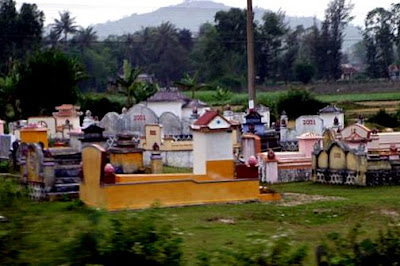 Our cyclo guides tried their best to give us a flavor of Hue, aside from the Forbidden Purple City. One of the interesting places was the Ngoc Huong Pagoda, and I couldn't tell you where it is, but if you're in Hue, flag a cyclo, and I bet they will know exactly where to take you. The pagoda is recessed from the street, and is surrounded by water, except for a paved alley which led to the main gate that was under lock and chain.
Our cyclo guides tried their best to give us a flavor of Hue, aside from the Forbidden Purple City. One of the interesting places was the Ngoc Huong Pagoda, and I couldn't tell you where it is, but if you're in Hue, flag a cyclo, and I bet they will know exactly where to take you. The pagoda is recessed from the street, and is surrounded by water, except for a paved alley which led to the main gate that was under lock and chain.As we rose from our cyclos to make our way to the Pagoda, there was an old man wading in the water, and it wasn't quite clear what he was doing, but perhaps he may have been cleaning the water. He had his hand on a canoe, and the stream was filled with leaves. His other hand held a bucket or basket; he may have been scooping water out of the canoe.
I'd like to add a post scrip to this scenario. This visit was taking place at a time when Viet Nam was at the height of the bird flu scare. We had been avoiding chickens like the plague; and you can imagine my alarm when two men came running toward us with a chicken in their hands (it was not dead).
 I probably scared them with my shrieks of "get away from me with this bird" ; perhaps they had not heard the news. Anyway, it seemed an eternity before anyone came to open the gate. A very regal looking monk, dressed in orange garb, came to unlock the gate and silently disappeared. I guess he realized that we were "tourists".
I probably scared them with my shrieks of "get away from me with this bird" ; perhaps they had not heard the news. Anyway, it seemed an eternity before anyone came to open the gate. A very regal looking monk, dressed in orange garb, came to unlock the gate and silently disappeared. I guess he realized that we were "tourists". We followed our guide into the Pagoda; remember to leave your shoes outside. This was not the first pagoda I had been to; but it would be unfair to compare the temple in Bangkok's Grand Palace grounds, where we chanted to the Emerald Buddha as we sat on the floor. That was a royal treat!! OK, back to Hue.
The altar onto which the likeness of Buddha rests is in the center. It is elevated, so that the lower levels can be used for offerings which are commonplace when the faithful come for prayers or spiritual guidance. Flowers and fruit are the most usual items to be offered. Before you can pray, or meditate, you must light 2 joss sticks; joss sticks are humongous incense sticks, and they are easily found in markets all over Viet Nam. We brought back a batch of them from the market we visited in Bac Ha . The guide proceeded to light the incense and I watched him, as he put his hands together, and up to his forehead, and bowed 3 times.
The altar onto which the likeness of Buddha rests is in the center. It is elevated, so that the lower levels can be used for offerings which are commonplace when the faithful come for prayers or spiritual guidance. Flowers and fruit are the most usual items to be offered. Before you can pray, or meditate, you must light 2 joss sticks; joss sticks are humongous incense sticks, and they are easily found in markets all over Viet Nam. We brought back a batch of them from the market we visited in Bac Ha . The guide proceeded to light the incense and I watched him, as he put his hands together, and up to his forehead, and bowed 3 times.
Then it was my turn, and I did the same. I learned during my trip, and by picking up a book on the Viet Namese people while there, that as a rule, Viet Namese people are not religious, but are extremely spiritual. They practice a form of ancestor worship, and go to great lengths to make sure that their ancestor's spirits are taken care of. Cemeteries in Viet Nam are extremely ubiquitous and colorful.
We did go around the chamber, and I saw portraits of monks that had died; one of them actually quite famous is pictured here; he had set himself on fire in protest. In front of each framed picture was an abundance of flowers, oranges, and other fruit. Following this cleansing exercise, we quietly walked outside, and headed for the gate. En route, I could see men at work, fixing a roof, and a burian tree with fruit that had apparently rotted. Durian actually don't look this bad. To see how pretty they really are, click on this link to go to the My Tho Fruit Market .






